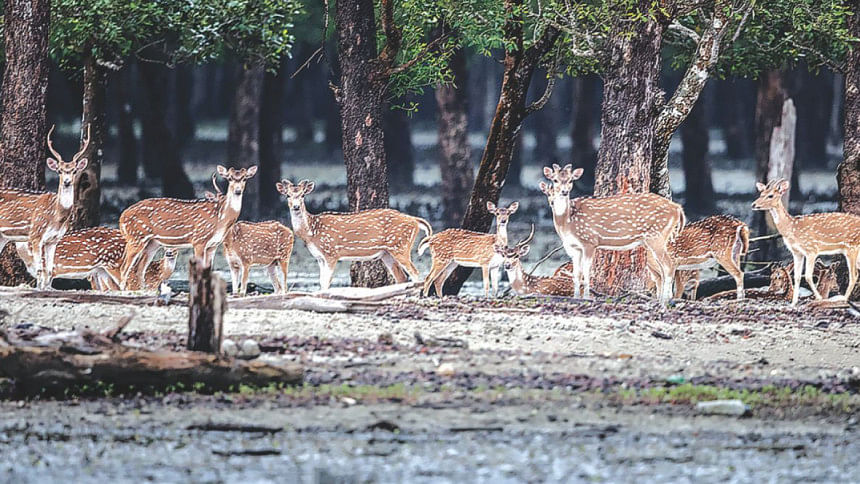Sundarban Wildlife

We often equate Sundarban's wildlife with the Bengal Tiger. Indeed, it is a magnificent creature and justifiably captures our imagination. But you have to be extremely lucky so see it during a tourist trip to Sundarban.
Thankfully, the diversity of wildlife in Sundarban extends well beyond the tiger. One can see many animals with moderate to high probability during a short tour of Sundarban.
In my experience, the most commonly seen animals are deer, wild boars, monkeys, monitor lizards and dolphins. Somewhat less likely, but still very possible, are sightings of crocodiles, otters and snakes. Smaller wildlife include mudskippers, several types of crabs, a wide selection of beautiful butterflies (including the Sundarban Crow butterfly), and various insects, including Apis dorsata, the giant honeybee.
Which is my favourite?
The Spotted Deer of Sundarban (Axis axis) is possibly the most beautiful deer in the world. It is common and widespread in Sundarban. These are exquisite creatures with a rich, rust-coloured coat with white spots which persist through their life. Watching them is always a pleasurable experience for me.
On every Sundarban trip I have taken, deer sightings have followed a pattern. Towards the beginning of the trip, soon after the launch enters the forest, I catch one or two glimpses of Spotted Deer. As the boat enters deeper into the forest, deer become more commonplace. For example, they can often be seen in places with stretches of Keora trees, where they stand on their hind legs to reach the leaves. The trees appear neatly and uniformly pruned at the height they can reach.
Before the tour ends, there may be a large-scale sighting. While walking on a boardwalk such as the one in Kotka, I have seen large herds of Spotted Deer in the distance. Their movement is often dictated by the tides which flood the land around the boardwalk. They come in to eat the Keora leaves when the tide is low and start moving back inland as the tide rolls in. Therefore, being there during low tide increases your chances of seeing a large herd.
The Rhesus Macaque monkey is sometimes found in the company of Spotted Deer.
If the deer evokes calm and affectionate feelings in us, the Estuarine Crocodile elicits awe and fear. It can grow as large as twenty feet and weigh up to a thousand kilograms. This reptile is considered endangered in Sundarban, with perhaps 150 mature individuals living in the waterways of the forest. More often than not, it is spotted by a staff member of the boat when, to the tourists, it appears as a log lying on the riverbank. But as the boat comes closer, it becomes possible to discern its features including the long scaly tail which it uses like a whip to attack unsuspecting prey. It may look sleepy and relaxed, but when the boat comes too close for comfort, the crocodile can move into water with startling swiftness.
On the waters of Sundarban you may see swimming lizards called Water Monitors. The confluence of two waterways is the best place to look for dolphins, which, being mammals, have to jump (briefly) for air.
Snakes hibernate during winter and are more likely to be seen in summer and monsoon. My most memorable snake was a Monocled Cobra that nested inside the labyrinthine root of a giant uprooted Keora tree. The smaller green and brown vine snakes are more common but camouflage well.
The Small-clawed Otter is by far the cutest wildlife of Sundarban. It is the subject of next week's column.
facebook.com/ikabirphotographs or follow “ihtishamkabir” on Instagram

 For all latest news, follow The Daily Star's Google News channel.
For all latest news, follow The Daily Star's Google News channel. 



Comments